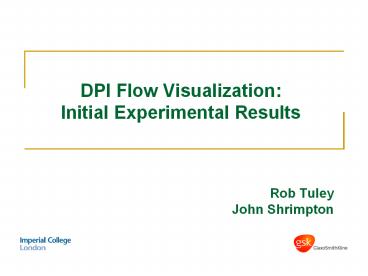DPI Flow Visualization: Initial Experimental Results - PowerPoint PPT Presentation
1 / 37
Title: DPI Flow Visualization: Initial Experimental Results
1
DPI Flow Visualization Initial Experimental
Results
- Rob Tuley
- John Shrimpton
2
Introduction
- Motivation
- Experimental Simplifications
- Experimental Design Procedure
- Some Results
- Evacuation Timescales
- Scope and Limitations
- Conclusions
- Future work
3
Motivation
- To gain a better understanding of how and why the
Diskus pocket evacuation occurs. - Ultimate aim is to computationally simulate this
process this is the first exploratory set of
experiments to produce a data-set to validate
these simulations.
4
Simplifications - Inhalation
- Inhalation simulated by a linear pressure ramp.
5
Simplifications - Geometry
- We tested 4 different geometries, although the
results from only two are being presented today
Square U-bend Diskus Replica
fully developed turbulent in-flow approx real-scale pocket geometry exact. includes cross-hairs at in-flow and out-flow.
6
Experiment Design
- Experimental rig designed in a modular fashion
for added flexibility.
log pressure sensor data
inhalator
pocket geometry
power supply and vacuum pressure source.
optical setup
7
Geometry modules
8
Pocket filling
- Excess powder swiped off from surface. Low
compression.
9
Inhalator module
- Pressure is controlled through a PI control
feedback loop.
10
Optical Setup
- The square U-bend geometry is backlit with a
halogen 1kW floodlight. - Diskus replica is front lit with the same halogen
flood.
11
Complete Setup
12
Parameter Space
- The two variables examined during the course of
the experiments were - Pressure ramp gradient 4 different ramps were
examined, both steeper and shallower than the
average real inhalation ramp of -30kPa/s. - Powder type 4 powders were chosen with various
shape and cohesive properties
time
Pulse -30kPa/s -10kPa/s -3.33kPa/s
pressure
13
Powders
Glass particles 0-50mm Nearly perfectly spherical. Small cohesion forces.
Aluminium particles 0-44mm Non-spherical flakes. Small cohesion forces.
Lactose 6 fines blend Non-spherical. Medium cohesion forces.
Lactose 15.8 fines blend Non-spherical. Large cohesion forces.
14
Video Results
channel
channel
Straight U-bend
Diskus Replica
15
Square U-bend flow features
Transient blow-back effect
16
Diskus Replica flow features
Strong influence of cross-hairs
17
Key Points
- No visible difference in evacuation between glass
and aluminium particles. - Two modes of evacuation EROSION
(glass/aluminium) and FRACTURE (15.8 fines
lactose). Lactose 6.5 fines behaviour lies
between these two extremes. - Differences evident between the two geometries
considered, but type of pocket evacuation and
powder behaviour visibly similar. - Difficult to quantify effect of pressure ramps
18
Intensity Post-processing
Normalised intensity 1
Area processed
Normalised intensity 0
19
Evacuation Timescales
20
Evacuation Pressures
21
Pressure Ramps - Glass
22
Pressure Ramps - Glass
23
Pressure Ramps - Lactose
24
Pressure Ramps - Lactose
25
Key Points
- Aluminium and glass evacuations are quantifiably
equivalent. - Lactose 15.8 fines blend seem to evacuate based
on instantaneous pressure, not gradient. - Glass/Aluminium evacuations, and to a lesser
extent lactose 6 fines blend seem to be
influenced by pressure gradient, but this may be
due to hidden 3D effects.
26
Scope
- Various pocket geometries can be connected to the
simulated inhalation apparatus. - Labview software PI control feedback loop means
any pressure profile can be simulated. - Running the software on a faster PC and DAQ card
would give better control loop performance. - Options to use various optical setups/different
lighting, etc.
27
Current Limitations
- There can be a certain amount of delay in the
pressure control PI loop. - With the current setup there is a high
noise-to-signal ratio from the pressure sensors. - Backlighting provides a 2D visualization
possibility that certain 3D effects might be
hidden. - Difficult to quantify possible leakage effects.
- Pocket filling method could be improved.
- Repeatability
28
Repeatability
- Each parameter combination was repeated a total
of three times. - Some parameter combinations were repeated after a
gap of a few days and changed geometries. - Examine glass and lactose 15.8 fines, at time
0.09s and 0.06s respectively, -30kPa/s.
29
Repeatability (glass 0-50mm)
30
Repeatability (lactose 15.8 fines)
31
Conclusions
- The evacuation of the simplified 2D U-shaped
geometry is similar to the evacuation from the 3D
Diskus replica geometry. - Cohesion has a much more important effect on the
pocket evacuation than shape. - The evacuation of lactose is based on
instantaneous pressure, not on pressure gradient.
This conclusion cannot be extended to any of the
other particle types. - A clearer understanding has been achieved of the
timescales and pressures required for particle
evacuation.
32
Future Work
- Using more sophisticated camera equipment from
EPSRC, better resolution images possible (approx
1000 x 1000 pixels). - This batch of experimental results not analysed
fully quantitatively at present, but possibility
of using techniques such as PIV or variance maps
on future results. - Experiment with a wider range of lactose blends?
- Data to be used on a validation basis for
computational simulations.
33
Discussion
- Data CD with a copy of this presentation and
further experiment description and results
available from Mark Palmer.
Questions?
34
Extras
35
Extras
36
Extras
37
Extras































